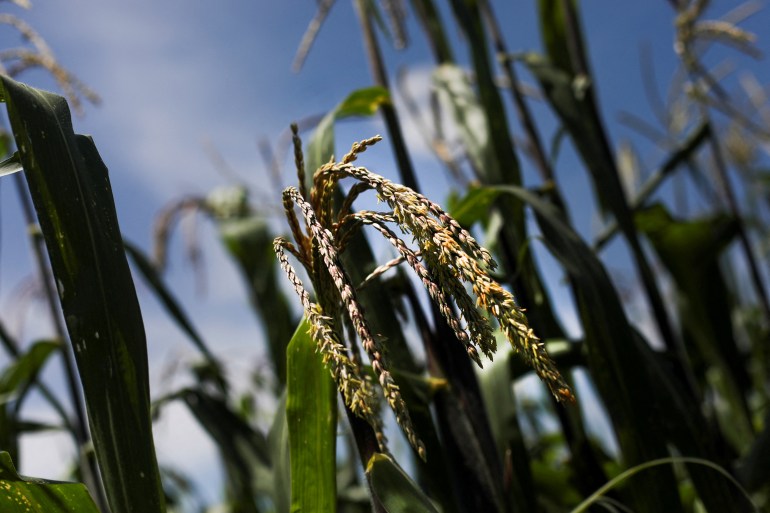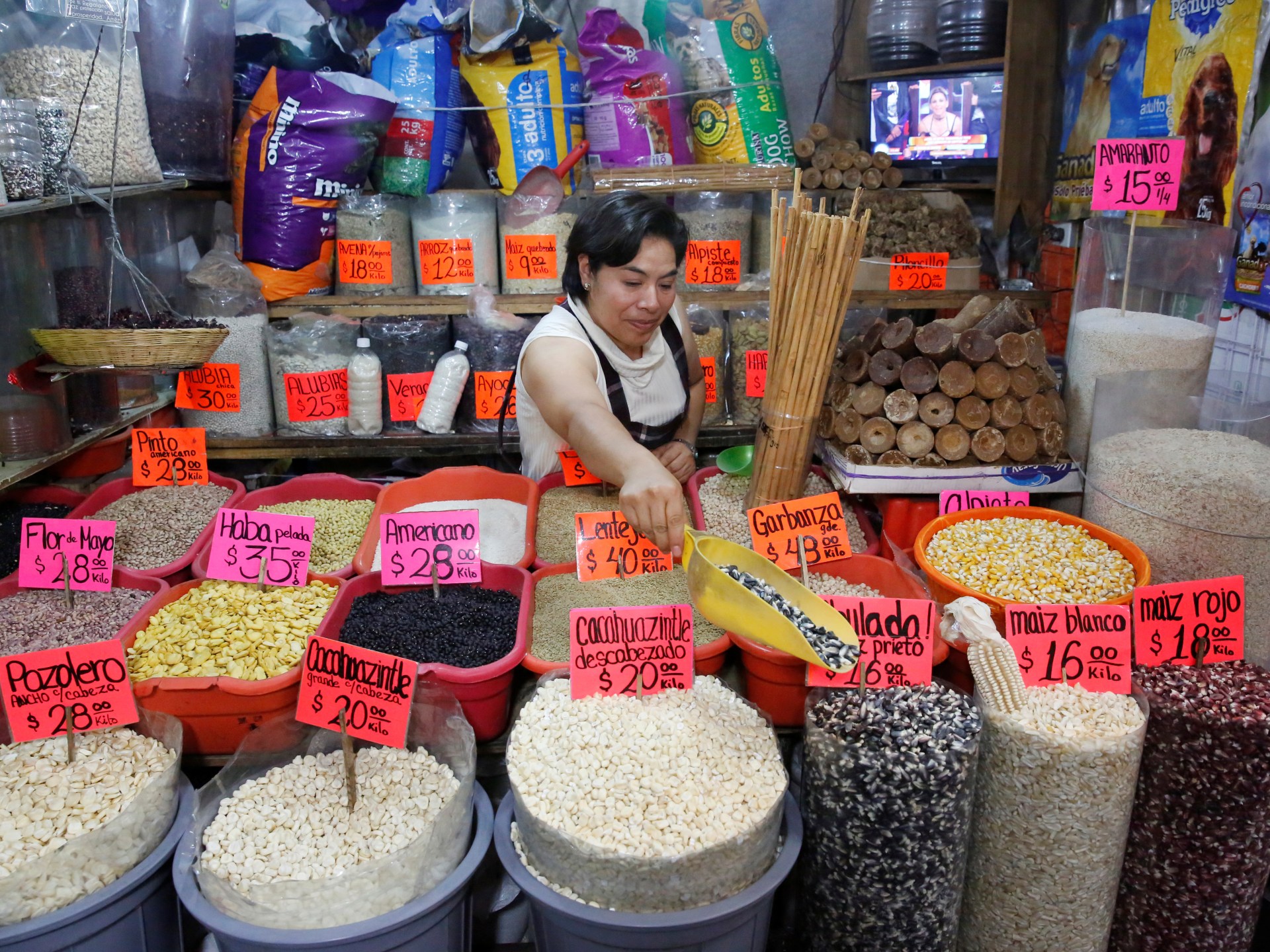Corn is sacred in Mexico. Its roots can be traced to Aztec and Mayan creation stories that exalted the arrival of a crop that was key to their survival.
In modern times, maiz, as it is known in Spanish, maintains its cultural, spiritual and political prominence as a staple in Mexican cuisine – and, increasingly, a brewing trade dispute.
Mexico has drawn a line in the sand with the United States when it comes to genetically modified corn, barring its use and import for human consumption, and gradually phasing it out for livestock feed or industrial uses.
After months of negotiations, US officials announced last month that they were pulling a lever under the United States-Mexico-Canada Agreement (USMCA), seeking an intermediary to resolve the dispute.
For Mexico, the issue is multi-pronged, but rooted in ensuring the affordability and availability of a crucial crop, experts say. For the US, it is about business. Corn is its biggest crop and the vast majority of it is genetically engineered.
Far from a regional issue, it is a feud that could have wide-reaching implications for importing and exporting nations, as evidenced also by Canada, which has added its voice to the proceedings and backed the United States in saying that Mexico’s position on biotech is “not scientifically supported” and could “unnecessarily disrupt trade in the North American market”.
As the role of industrial agriculture comes under added scrutiny in the era of climate change, Mexico’s stand to protect small-scale farmers is one that others are watching closely.
“I would say Mexico is at the forefront of the world,” said Ernesto Hernández López, a professor at Chapman University in California, who specialises in international law and food law.
What is this trade dispute about?
It is illegal to grow genetically modified corn on Mexican soil. In 2020, Mexico expanded the prohibition with a decree banning all GMO corn, including imports, as of January 31, 2024, on the grounds that doing so protected its food security, its rural communities, its food heritage and the health of its people.
It also announced that it would impose strict limits on the import, distribution and use of the contentious herbicide glyphosate – widely used in GMO farming – culminating in its complete ban by that date. Glyphosate is a well-known weed killer whose potential to cause cancer is the subject of heated debate.
In February of this year, Mexico issued another decree that softened its stance. It scrapped the date by which animal feed corn – which represents the vast majority of imports from the US – is banned. This means yellow GMO corn used for animal feed can continue to cross the border, although the decree still states the intention of “gradually substituting” it, but with no date set.
The decree maintains the ban on GMO corn used for human consumption in dough and tortillas, which is white corn. The Mexican government said Mexico produces enough white corn that is free of GMOs to sustain itself.
“Mexico is the centre of origin of more than 55 strains of maize. The food security policy of the Government of Mexico consists of preserving this biocultural heritage,” the government said in a statement, in addition to preserving the sustainable farming practices of peasant communities. “This has to do with consolidating sovereignty and food security in a central part of Mexican culture.”
The move rankled the US, which considered it an affront to the free trade rules of the region. After multiple meetings and consultations with Mexican officials, the US announced in August it would seek to establish a dispute settlement panel under the USMCA, arguing that the Mexican decree “undermines the market access” Mexico had agreed to provide.

“Mexico’s approach to biotechnology is not based on science and runs counter to decades’ worth of evidence demonstrating its safety and the rigorous, science-based regulatory review system that ensures it poses no harm to human health and the environment,” said Agriculture Secretary Tom Vilsack in a statement.
“Innovations in agricultural biotechnology play a key role in advancing solutions to our shared global challenges, including food and nutrition insecurity, the climate crisis and the lingering effects of food price inflation,” he said.
Mexico says it will not back down from its position, which it asserts is rooted in science. Officials have said that the United States has refused to take part in additional scientific research on the health impact of GM corn. “[That] makes no sense because if a government cares about people’s health, then they would have no problem doing further research on the health implications,” Mexican Economy Minister Raquel Buenrostro said in August.
How big of a deal is this?
Mexico bought nearly $5bn worth of corn, the vast majority of it yellow GMO corn that is destined for livestock feed, from the US in 2022 making it the second-biggest destination for the US crop. Some 17 million tonnes of yellow corn flowed south of the border last year.
While more than 90 percent of the corn grown in the US is genetically engineered, white corn represents a small portion of US exports to Mexico, and “little if any” is genetically modified, suggesting to researchers that the dispute will have a “limited effect” on American farmers in the short term.
Nonetheless, trade unions, such as the National Corn Growers Association, maintain the ban would be “catastrophic” for US producers and threatens the integrity of the USMCA. Certain states, like Illinois for instance, send most of their corn exports to Mexico.
How long has this been going on?
In Mexico, the push to protect corn is not new. A national campaign known as “Sin Maiz No Hay Pais” – Without Corn, There Isn’t a Country – launched in 2007, representing a cross-section of some 300 organisations that included rural farmers, environmentalists, consumers, human rights and women’s organisations.
Their goal has been to make food security a central concern for politicians, pushing for the prohibition of genetically modified corn, and against industrialized agricultural monopolies.
In 2013, a collective of farmers, consumers, and environmentalists launched a lawsuit that sought to ensure that GMO corn seeds continued to be denied entry into Mexico. In 2021, the Mexican Supreme Court ruled in their favour.
For Víctor Manuel Chima Ortíz, a member of Sin Maíz No Hay País, the issue has to do with national sovereignty, and ensuring that neither the US nor Canada “intervene in the decisions that the Mexican government is making to safeguard human rights related to this issue”.
“The right to food, the right to health, the right to a healthy environment, the right to access to information,” are all issues that are at stake, said Ortiz.
“But there is a background that is fundamental to also be able to sustain Mexico’s decision, which is the cultural value, the historical value, the symbolic value that corn has,” he noted. “There are many territories, there are many communities, Indigenous peoples that have corn as a symbolic element, as an identifying part of their cultures.”
What are the arguments in this case?

The US’s position is clear. It argues that Mexico does not have a scientific leg to stand on, and that the move is in violation of a free trade agreement. While Mexico still has to elaborate on its arguments, the question of biodiversity is key.
The health issue largely turns on the use of glyphosate, a weed killer used extensively in GMO farming, which a World Health Organization agency has said is “probably carcinogenic to humans”, a claim that the US Environmental Protection Agency disputes. The European Food Safety Authority recently gave the pesticide its stamp of approval, to the shock of environmentalists. Bayer, the German chemical giant that owns glyphosate and maintains its safety, has paid out billions to settle cancer lawsuits.
“Where the fight is going to be is on Chapter 9 [of the USMCA], which is about food safety,” said Lopez. “It’s a very procedural technical issue, and it depends on whether the panellists agree with Mexico’s description of the science, and that it met its procedural disclosure obligations, versus the United States’s claims that there is no science and there’s been no disclosure.”
“That’s the same fight from the ’90s with beef hormones, and biotech in 2006,” he said.
In 2006, the WTO ruled in favour of the US when it contested restrictions from the European Union on genetically modified crops.
What are the ramifications of this move?
“The United States is very focused on protecting the product,” said Lopez, referring to its corn exports. European and Chinese markets are not as open as they used to be, and Mexico represents a huge market.
“For Mexicans, what is politically important is being able to secure corn for masa [dough] and corn for tortillas. And that’s what the decreto [decree] this year has focused on for the consumer, and rural agriculture, to make sure that people aren’t losing their livelihood or having more pressure to migrate,” said Lopez.
“What will really spell disaster for any president [in Mexico] is that he or she has to deal with rising corn prices that affect what people eat,” he added.
Ortiz, from Sin Maiz, No Hay Pais, said this battle will resonate outside of Mexico’s borders, noting that countries such as Guatemala, Bolivia and Colombia also have native corn.
The dispute settlement provision triggered by the US is contained under Chapter 31 of the USMCA. It establishes an independent panel of five members to investigate and rule on Mexico’s GMO corn. Once the panel is struck, it is expected to present an initial report within 150 days. Each country then gets 60 days to review and make comments on the report. The panel would produce findings of fact in the dispute, determine if the measure adopted by Mexico goes against the trade agreement, and make recommendations to resolve the dispute.
All this means that it will be 2024 before this situation comes to a head.
